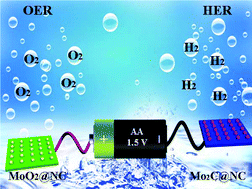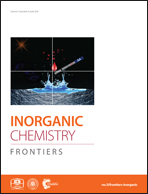Three-dimensional supramolecular phosphomolybdate architecture-derived Mo-based electrocatalytic system for overall water splitting†
Abstract
With hydrogen bond-directed three-dimensional phosphomolybdate-based supramolecular architecture as a precursor, a Mo2C composite material (Mo2C@NC) supported by nitrogen-doped carbon matrix was fabricated successfully through calcination. In this composite material, Mo2C particles with size about 5 to 8 nm disperse evenly in the framework of nitrogen-doped mesoporous carbon matrix. In acid media, to achieve a current density of 10 mA cm−2, the overpotential required was 142 mV with a Tafel slope of 63 mV dec−1. Under basic conditions, the overpotential reduced to as low as 56 mV with a Tafel slope of 59 mV dec−1. To realize overall water splitting, MoO2-based composite material (MoO2@NC) with nitrogen-doped carbon as matrix was obtained using the same precursor as Mo2C@NC. MoO2@NC exhibits excellent oxygen evolution reaction (OER) performance with an over potential of 302 mV. With Mo2C@NC as cathode and MoO2@NC as anode, an efficient electrolyzer was constructed, which required a cell voltage of 1.60 V to achieve a current of 10 mA cm−2 in 1.0 M KOH. Furthermore, besides overall water splitting, Mo2C@NC also shows striking catalytic removal property towards 4-nitrophenol and Rhodamine B.

- This article is part of the themed collection: Inorganic Chemistry Frontiers HOT articles for 2018


 Please wait while we load your content...
Please wait while we load your content...